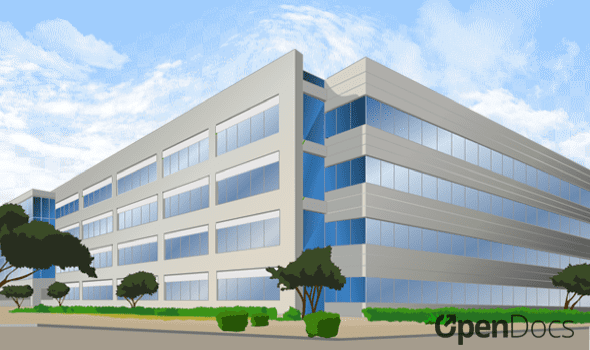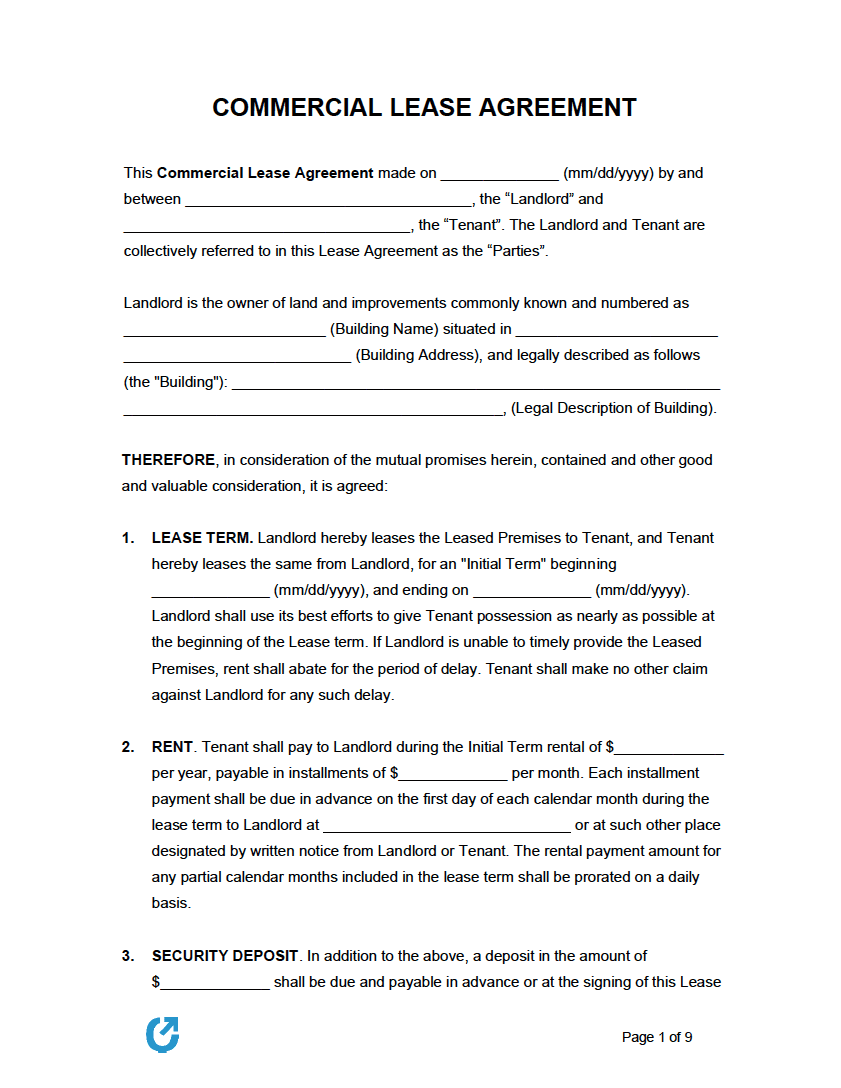Commercial Lease Agreement Templates
A commercial lease agreement is a contract used by property owners and landlords to rent out all, or a portion of a commercial building to a tenant that will use it for business purposes. Commercial property includes apartment buildings, offices, retail spaces, restaurants, industrial warehouses, hotels, and land.
Summary
|
By State
- Alabama
- Alaska
- Arizona
- Arkansas
- California
- Colorado
- Connecticut
- Delaware
- Florida
- Georgia
- Hawaii
- Idaho
- Illinois
- Indiana
- Iowa
- Kansas
- Kentucky
- Louisiana
- Maine
- Maryland
- Massachusetts
- Michigan
- Minnesota
- Mississippi
- Missouri
- Montana
- Nebraska
- Nevada
- New Hampshire
- New Jersey
- New Mexico
- New York
- North Carolina
- North Dakota
- Ohio
- Oklahoma
- Oregon
- Pennsylvania
- Rhode Island
- South Carolina
- South Dakota
- Tennessee
- Texas
- Utah
- Vermont
- Virginia
- Washington
- West Virginia
- Wisconsin
- Wyoming
What is a Commercial Lease Agreement?

A commercial lease agreement is a contract between a landlord and a business tenant, usually lasting three to five years. The tenant makes monthly payments for the property’s use. Unlike residential leases, commercial leases have less state protection, so both parties must rely on negotiation and knowledge to secure financial and legal protection during the contract.
What to Include in the Agreement
Certain clauses should be included in every commercial lease agreement. These include:
Identification of the Parties
This clause identifies the parties involved in the agreement: the landlord and the tenant. It should include their legal names, contact information, and addresses.
Example Clause:
| This Commercial Lease Agreement (“Agreement”) is entered into on this [DATE] by and between [LADNDLORD NAME], having an address at [LANDLORD ADDRESS] (“Landlord”), and [TENANT NAME], having an address at [TENANT ADDRESS] (“Tenant”). |
Description of the Premises
This section describes the commercial property being leased, including its address, square footage, and any specific areas or facilities included.
Example Clause:
| The Landlord hereby leases to the Tenant the premises located at [PROPERTY ADDRESS], consisting of approximately [#] square feet of space (“Premises”). |
Term of the Lease
Specify the length of the lease, including the start and end dates. Also, mention any options for renewal or termination procedures.
Example Clause:
| The lease term shall commence on [START DATE] and expire on [END DATE] unless terminated earlier in accordance with this Agreement. Tenant shall have the option to renew the lease for an additional term of [RENEWAL TERM] upon written notice to the Landlord not less than [NOTICE PERIOD] before the expiration of the initial term. |
Rent and Security Deposit
Outline the rent amount, payment schedule, and any late payment penalties. Also, include the security deposit amount and conditions for its return.
Example Clause:
| Tenant agrees to pay a monthly rent of $[RENT AMOUNT] due on the first day of each month. A late fee of $[LATE FEE] shall be imposed if the Landlord does not receive rent within [#] days of the due date. Tenant shall also pay a security deposit of $[SECURITY DEPOSIT] upon signing this Agreement, to be returned within [#] days after the termination of the lease, subject to any deductions for unpaid rent, damages, or other charges owed by the Tenant. |
Maintenance and Repairs
Define the responsibilities of both the landlord and tenant concerning maintenance and repairs of the property, including routine maintenance, repairs, and replacements.
Example Clause:
| The Landlord shall be responsible for maintaining the structural integrity of the Premises, including the roof, foundation, and exterior walls. The Tenant shall be responsible for maintaining the interior of the Premises in good repair, including keeping the Premises clean and free from damage, and promptly notifying the Landlord of any necessary repairs. |
Alterations and Improvements
Detail any alterations, improvements, or additions the tenant may want to make to the property, along with the approval process and responsibility for costs.
Example Clause:
| Tenant shall not make any alterations, improvements, or additions to the Premises without obtaining the prior written consent of the Landlord. Any approved alterations shall be made at the Tenant’s expense and shall become the Landlord’s property upon the lease’s termination unless otherwise agreed in writing. |
Insurance and Liability
Explain the insurance requirements for both parties and outline the extent of each party’s liability in case of damage or injury on the property.
Example Clause:
| At its own expense, the tenant shall maintain comprehensive general liability insurance with minimum coverage limits of $[AMOUNT] per occurrence for bodily injury and property damage. The Landlord shall maintain property insurance on the Premises. Neither party shall be liable to the other for any loss or damage caused by events outside their reasonable control, including but not limited to fire, flood, earthquake, or other natural disasters, except to the extent that such loss or damage is caused by the negligence or willful misconduct of the party seeking to avoid liability. |
Default and Termination
Describe the conditions that constitute a default on the lease agreement, such as non-payment of rent or breach of other terms. Also, include the consequences and procedures for termination due to default.
Example Clause:
| In the event of a default by the Tenant, such as failure to pay rent or breach of any other term of this Agreement, the Landlord may provide written notice to the Tenant specifying the default. If the Tenant fails to cure the default within [#] days of receiving the notice, the Landlord may terminate this Agreement and pursue any available legal remedies. Upon termination, Tenant shall vacate the Premises and remove all personal property. |
Subleasing and Assignment
Explain the conditions under which the tenant may sublease or assign their lease to another party, and the process for obtaining the landlord’s approval.
Example Clause:
| Tenant shall not sublease, assign, or otherwise transfer any interest in the Premises without obtaining the prior written consent of the Landlord, which consent shall not be unreasonably withheld. Any approved sublease or assignment shall be subject to the terms and conditions of this Agreement. |
Governing Law and Dispute Resolution
Identify the governing law of the lease agreement and the method for resolving disputes, such as negotiation, mediation, or litigation.
Example Clause:
| This Agreement shall be governed by and construed in accordance with the laws of the State of [STATE]. Any disputes arising out of or relating to this Agreement shall first be attempted to be resolved through good faith negotiations between the parties. If negotiations fail, the parties agree to submit the dispute to mediation before resorting to litigation. |
Types of Commercial Leases (3)
Commercial leases fall into three categories based on how rent is determined: Gross, Net (with three sub-types), and Modified Gross.
- Gross Lease: In a Gross Lease, tenants pay a flat fee monthly or per rental term, placing most liability on the landlord. However, landlords can make energy-efficient modifications to save money.
- Net Leases: Net leases come in three types: Triple Net (NNN), Double Net (NN), and Single Net (N). All three types require tenants to pay additional costs and fees besides the base rent, utilities, and janitorial expenses.
- Triple Net Lease: Tenants pay property taxes, insurance, and common area maintenance (CAM) charges. An “absolute triple net lease” transfers all property risks to the tenant.
- Double Net Lease: Tenants pay property taxes and insurance.
- Single Net Lease: Tenants pay property taxes.
- Modified Gross Lease: A Modified Gross Lease combines aspects of both Gross and Net leases, offering a compromise. Rent remains fixed regardless of utility costs, and both parties can negotiate on specific utility costs.
